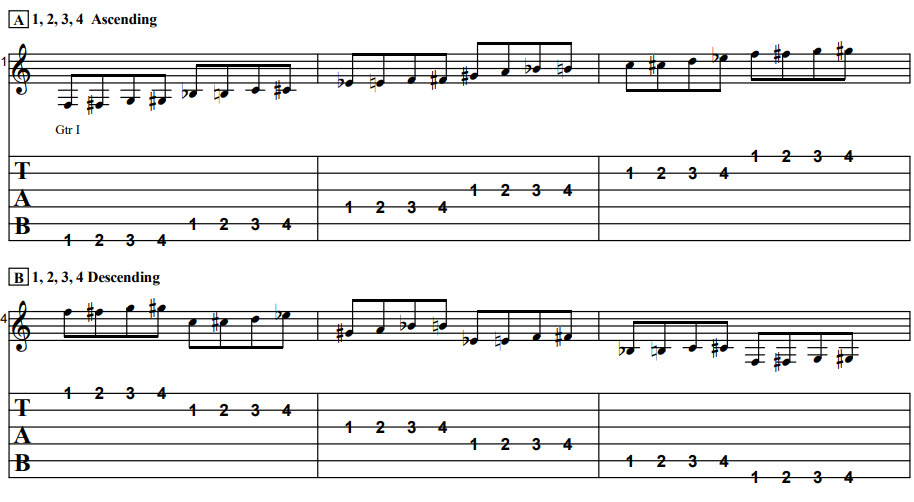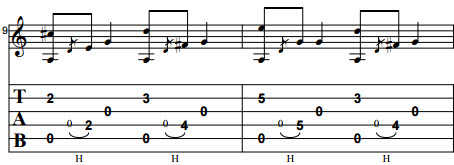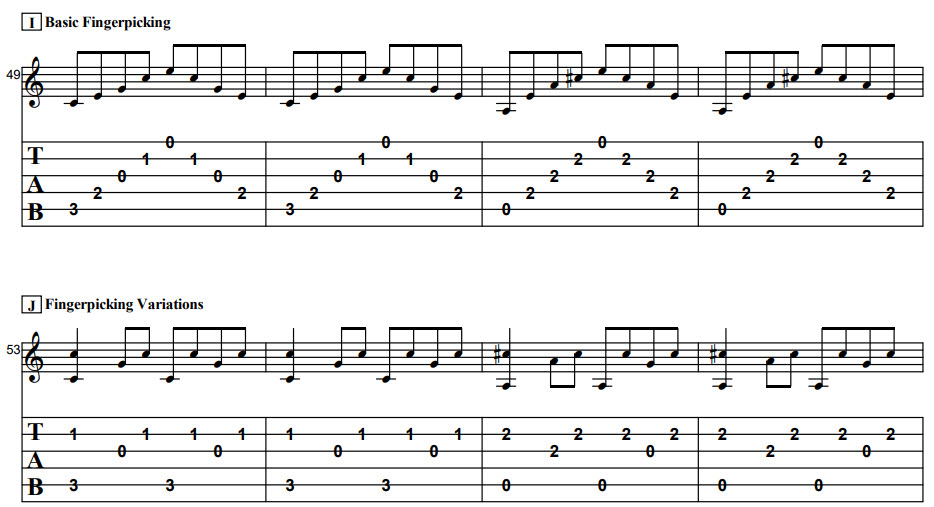In this lesson, we’re going to take a look at a few ways you can improve your acoustic guitar technique. We’ll go through some drills and exercises that you can use daily that will help you play faster, cleaner, and better.
We’ll be looking at exercises that will benefit both the picking hand and the fretting hand. Also, these exercises will help you with your rhythmic timing.
Lesson Video
First, watch the video, then read the lesson content below the video.
Here’s what was discussed in the video:
The 1, 2, 3, 4 Exercise
This first exercise will help tie the picking hand and the fretting hand together.
To perform this exercise, we’ll play the first four frets, one note at a time, on all six strings (beginning on the low E).
Pick the first note with a down stroke and the second with an upstroke. Proceed to pick all notes with this down, up, down, up pattern. Alternating between up and down allows us to build greater speed. This is called alternate picking.

The 1, 2, 3, 4 Finger Confusion Variation
Here’s a weird one for you. You’ll find that your fingers don’t want to cooperate with you. This “finger confusion” works your mind as much as your fingers. With repeated practice, this type of exercise can help build new musical neural pathways.
This exercise is like the 1, 2, 3, 4 Exercise, but with one big twist.

The One Fret Per String Exercise
This exercise, for some reason, happens to be one of my favorites…
It’s another mind-bending, finger confusion exercise that will make you play something that you’re unlikely to see “in the wild”. That is, it’s a type of phrase that you likely wouldn’t play in a song. That’s okay because we’re not performing these exercises for their musical qualities. We practice them to develop our skill!
We’ll start by playing the first fret of the low E string, then proceed to play the second fret of the A string, the third fret of the D string, and finally the fourth fret of the G string. Continue the exercise by using the same pattern beginning on the A string and D string.
It’s a tough little exercise because it feels so unnatural, but it’s a true skill builder!

Strength Building Hammer-Ons And Pull-Offs
Here’s a series of exercise to practice that will build strength in your fretting hand and help you play cleaner and faster.
First, hammer-on and pull-off from the first and second frets of the low E string. Try to make each note as clear and even as possible. Switch to the A, D, G, B, and then the high E string all while maintaining the hammer-on/pull-off pattern.

There are several variations of this exercise that you can practice. For these variations, stay on the first four frets while using the same finger number as the fret. For example, to fret the notes use the first finger on first fret notes, second fret notes, use the second finger to fret the second fret notes, and so on. It’s easy as 1, 2, 3, 4.
Try these variations:
- The first fret to the third fret
- Second fret to the third fret
- The first fret to the fourth fret
- Second fret to the fourth fret
- The third fret to the fourth fret
View the Acoustic Drills And Exercises PDF for the tab of these variations.
Fingerpicking Exercises
We’ve spent a lot of time working on the fretting hand, but what about the other hand?
Fret the standard C chord and finger pick each note one at a time. Use your thumb for the A string, first finger for the D, second finger for the G, third finger for the B, and fourth finger on the high E string. Arpeggiate the chord going up in pitch and going down and slowly try to increase speed while maintaining clean playing. Try this simple pattern with other open chords such as the A chord and E chord (use your thumb for that low E and A string when playing all six strings).
Once your fingers feel nimble, try creating your own finger picking patterns. It’s easy to do, in theory.

Getting Crazy
When practicing exercises it’s ideal to consistently challenge yourself to play things that are a little beyond you comfort level. Isn’t the whole point of practice to get better? How can you improve without getting a little “crazy”.
An idea for an exercise that falls into this category would be speedy ascending phrases.
Try hammering-on from the first fret to the third fret using the first and third fingers. Play that once and then move everything up one fret. The fingerings are the same it’s just that we slide everything up one fret. We can ascend the entire fretboard (or most of it) in a fast fashion. It’s tough to do!
You can do so many variations of this idea just as we did with the hammer-on and pull-off exercises. Isolate a couple of fingers and fly up that fretboard.

Setting Up A Routine
These exercises are not meant to be played once and forgot about. No, you should include them in your regular practice routines. They are a great way to warm up, so I suggest spending 5 or 10 minutes on them at the beginning of each practice. Pick 3 or 4 exercises for each session. In your next session, pick 3 or 4 different ones. Mix it up and have fun!
When you consistently use them you’ll see a drastic improvement in your playing over a period of time. It might not be that noticeable at first, but it’ll be happening.
How about a handy little worksheet that you can print out or download? The PDF linked below has all the exercises that we discussed and several variations. Remember, your homework is to start each practice session with 5 to 10 minutes playing 3 or 4 of these exercises.